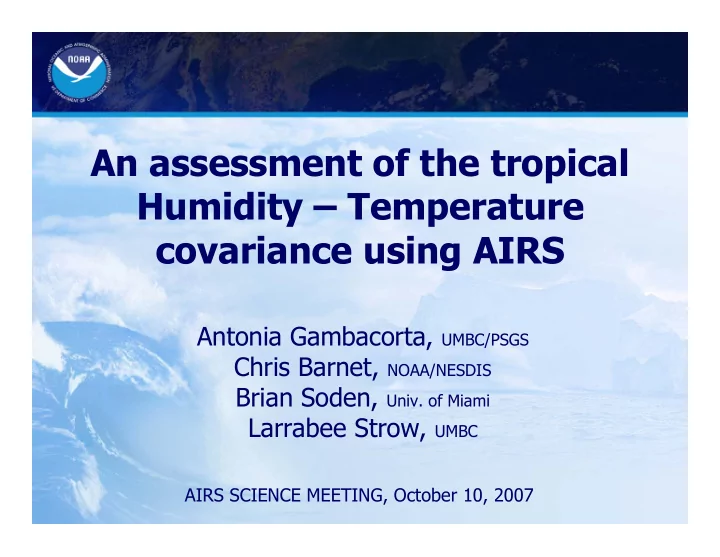

An assessment of the tropical Humidity – Temperature covariance using AIRS Antonia Gambacorta, UMBC/PSGS Chris Barnet, NOAA/NESDIS Brian Soden, Univ. of Miami Larrabee Strow, UMBC AIRS SCIENCE MEETING, October 10, 2007
Outline • We investigate the horizontal and vertical structure of covariance between water vapor and temperature in the tropical troposphere using AIRS • We compare with previous study (radiosondes, ECMWF, GCMs) which have focused only on the covariance of tropical mean quantities, and have shown a general uniform positive correlation through the whole troposphere • AIRS high spectral resolution and the radiance cloud clearing algorithm allow for high vertical resolution and excellent spatial coverage respectively. This enables a more comprehensive analysis than has previously been possible. • AIRS shows large spatial gradient in the local covariance between water vapor and temperature – Submitted paper: A. Gambacorta, C. Barnet, B. Soden, L. Strow, “An assessment of the tropical humidity-temperature covariance using AIRS”, GRL, 2007 • Implications for climate 2
Motivations Water vapor is the most active greenhouse gas in regulating the radiation budget of the atmosphere • The Clausius –Claperyon equation : e s ~exp(-1/T) Temperature Moisture content Positive Feedback • Lindzen hypothesis : the vertical distribution of water vapor in the tropics is characterized by three distinct regions: the convective domain of the boundary layer, the free tropical troposphere and the outflow domain of deep convection: the dependence of water vapor on temperature may be strongly height dependent In the Upper Troposphere (UT): In the Upper Troposphere (UT): Temperature Convective Tower Height Precipitation UT moisture content Drying negative Feedback 3
Fractional change of q wrt T dOLR d ln q � � d ln q 1 dq ~ m dT q a dT m (Ref.: Huang and Soden, GRL, 2005) q a =Annual mean specific humidity q m , T m = monthly mean specific humidity and temperature 4 [Ref.: Huang and Soden, GRL, 2005; Sun and Oort, J.Climate,1995;]
AIRS Dataset • 3x3 degree gridded subsets of AIRS products (no spatial bias) from August 2003 to April 2007. • NOAA emulation of version 5 retrieval algorithm, using a version 4–like rejection criterium: – To preserve whole accepted retrieval profiles – To increase sampling in tropical cloudy convective regions. • KEY Elements of AIRS database for this analysis : – Cloud clearing: increase of the daily yield of observational data up to 80% (no clear-sky bias typical of satellite measurements) – Accurate retrieval algorithm: ~1 K for temperature; ~10 and 20% rms for water vapor in the tropical lower-middle and upper troposphere respectively – Uniform spatial coverage and high vertical resolution of ~2-3km for T and ~ 2km for WV 5
Fractional change of q wrt T, from AIRS [ , %/K ] 300mb 600mb 850mb 6 Clausius-Clapeyron regime ~7%/K
AIRS (left) vs NOAA GFDL model (right) August 2003 – April 2007 January 1998 – December 2004 300mb 600mb 850mb 7
Comparison with the NCEP vertical velocity field August 2003 – December 2004 8
Fractional change of q wrt T, from AIRS [ , %/K ] • AIRS shows a strong latitude-longitude dependence in the structure of the water vapor – temperature covariance, particularly in the free troposphere, where extended negative and positive covariance up to one order of magnitude larger than the Clausius-Claperyon eq. are found • Highest positive responses found in the upper troposphere region • Highest negative responses found in the middle troposphere region • Comparisons with the NOAA GFDL model show same order of magnitude in the variability of the water vapor – temperature cavariance values • Other mechanisms regulating the water vapor distribution in the free tropical troposphere besides local temperature, appear to be connected to the patterns of the large scale circulation: regions of positive and negative covariance roughly resemble regions of the ascending and descending branches, respectively, of the tropical circulation 9
Zonal cross section AIRS GFDL 10
Factional changes of q and T tropical averages (Ref.: Huang and Soden, GRL, 2005) __ AIRS 3x3 degree spatial resolution __ GFDL full spatial resolution __ Const RH hypothesis -- AIRS -- GFDL on a common spatial subset -.- AIRS further degraded on same vertical res of GFDL • When we average over the whole tropical domain, the regression slopes are of the same order of magnitude of the Clausius Claperyon regime at ALL levels in the troposphere 11
Conclusions • Exploiting the high vertical resolution and excellent spatial coverage, the AIRS instrument shows a complex horizontal and vertical structure of the humidity- temperature covariance •In the upper troposphere region, water vapor appears to be most strongly and overall positively tied to local temperature changes •Negative correlations characterize extended regions of the free troposphere, particularly at mid altitude levels ( ~600mb) where tropically averaged correlations become negative. •Values up to one order of magnitude larger than the Clausius-Clapeyron regime , suggests that other processes besides local temperature, play a more important role in determining moisture changes in the free troposphere, and appear to be connected to the transport mechanisms of the large-scale tropical circulation. 12
Future works: •Recent findings [Vecchi et al., Nature , 2006] of a weakening process of the tropical circulation due to anthropogenic forcing lead to new questions: • What are these moistening and drying sources? • How do they relate to the tropical circulation? • What is their overall radiative role in the Earth’s energy budget? 13
14
15
Recommend
More recommend